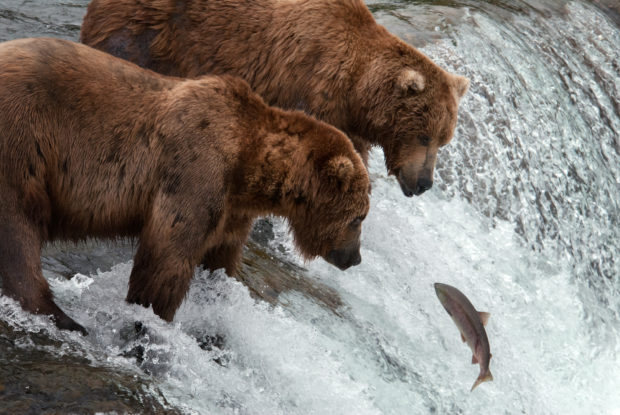We have much more to do and your continued support is needed now more than ever.
Salmon migration: Showing the way toward a healthy ecology
Salmon migration is a Homerian journey and an iconic wildlife event. It prompts us to think about the extraordinary energy that drives this epic movement for many animals across all landscapes—and the increasing barriers they face.
Dodging many barriers and predators, salmon are stunning long-distance swimmers. Their journey begins in the depths of our inland river systems, flowing Westward to the swells of the coastal ocean, and back. The return migration to native streams to spawn is a daring race against time that involves a labyrinth of impediments and vast distances. Swimming against the current, upstream, some runs reach up to 950 miles. Other runs reach lofty elevations as high 6,500 feet. For all salmon, the goal is singular: to find the ideal gravelly bottom for reproductive success.

Uniquely mastering different aquatic environments, migrating salmon represent thousands of years of evolutionary fine tuning. Their journey embodies an amazing transformation, allowing them, across their life cycle, to alternate between freshwater streams and rivers and salty ocean.
Salmon migration has broader implications for the larger ecosystem, in ways that aren’t readily obvious. In the Columbia River Basin, for example, salmon are a keystone species upon which 130 other species need to thrive. Humans too, for millennia, have thrived on salmon, but more recently however, have made it hard for these fish to succeed. We’ve created conditions that are near impossible for them to make their way to the ocean and return to spawn. Their migration routes have been uprooted. Warming waters, languishing behind massive dams, have put salmon at grave risk, for hot water kills cold water fish. The converging threats to salmon migration has had grave impacts in the Columbia River Basin. Today, 13 species are threatened and drawing near extinction.
If salmon and their spectacular migration were to disappear from the ecological equation, suddenly our world would look very different. It’s a domino effect that will impact sea mammals, birds, even trees. Salmon eggs feed ducks and raccoons. Juvenile and adult salmon are sustenance for river otters, bears and eagles. After spawning, salmon become the nutrients in the soil to fuel the growth of ponderosa pines and other riparian places along river banks.
Without salmon, hungry bears go to other sources of food, dwellings and garbage can, creating more human wildlife conflicts. If salmon disappear, a crucial nutrient source for the system disappears. Species would need to adapt. But could they?
The salmon’s epic quest to find the sea and return to spawn, shines a light on the sheer energy of migration across landscapes. The drive of animals on the move—by water, by land, by sea—is one of the most awe-inspiring events wildlife can demonstrate. Be it pronghorn or pelicans, their migration is driven by the same needs: to exploit high-quality resources to increase reproductive success and to move from deteriorating conditions to increase their chances for survival.
Unfortunately, across all landscapes, as movement is increasingly under threat from man-made impediments, all migration is under increasing strain. Against this growing threat, we must confront a simple truth: We must ensure an environment in which wildlife survive for it is essential for our survival as well.
Andrew Jakes is a wildlife biologist who specializes in movement ecology.
—





















